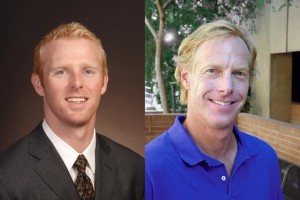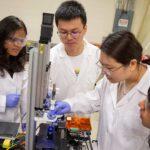
Mayo Clinic collaborations focus on Alzheimer’s, aneurysm treatments


ASU engineers David Frakes (left) and Michael Sierks will team with Mayo Clinic researchers to seek more effective diagnoses and treatment of Alzheimer’s disease and cerebral aneurysms.
Posted March 29, 2013
Two Arizona State University engineers are members of research teams that have each won $100,000 grants from a group of venture capitalists, entrepreneurs and medical device manufacturers to pursue advances in the treatment of Alzheimer’s disease and cerebral aneurysms.
Michael Sierks, a professor in the School for Engineering of Matter, Transport and Energy, one of ASU Ira A. Fulton Schools of Engineering, is collaborating with Terrone L. Rosenberry and Pritam Das, research scientists with the Mayo Clinic’s Department of Neuroscience.
They are working on the project “Development of nanobodies that target amyloid-β oligomers for individual diagnosis in Alzheimer’s disease.”
David Frakes, an assistant professor in the School of Biological and Health Systems Engineering and the School of Electrical, Computer and Energy Engineering, is teaming with physician Brian Chong in Mayo Clinic’s Division of Neuroradiology.
Frakes and Chong are leading the project “EndoVantage Interventional Suite (EVIS) for personalized clinical management of cerebral aneurysms.”
Personalizing health care
The teams were the two selected to receive the grants from among more than 20 teams that submitted proposals. The awards are jointly sponsored by the Mayo Clinic Center for Individualized Medicine at Mayo Clinic link to and ASU’s Office of Knowledge Enterprise Development.
“The Center for Individualized Medicine works to translate research breakthroughs into real-world applications that can improve health care for our patients,” says Jeremy L. Friese, director of New Business and Development for the center.
“The quality of applications received for this opportunity reflects the superior quality of use-inspired research activities engaged in by ASU and Mayo Clinic researchers in the area of health and personalized medicine,” says Sethuraman “Panch” Panchanathan, senior vice president of ASU’s Office of Knowledge Enterprise Development. “Through this collaborative effort, we are able to rapidly advance commercialization of novel ideas with the potential for significant economic development.”
Arizona Technology Enterprises (AzTE), the technology venturing arm of ASU, is managing the initiative on behalf of ASU.
Improving diagnostic ability
Sierk’s team focuses on engineering a set of reagents — substances used in chemical analysis — that can be used for early diagnosis of Alzheimer’s disease and as therapeutic tools for treating it.
Alzheimer’s is a neurodegenerative disease that affects the memory, cognitive ability and behavior. As the brain ages, the proteins produced in the brain that ordinarily promote healthy bodily functions begin to misfold and aggregate, leading to irreversible brain damage.
The damage is done in the intermediate phase of the disease, as the proteins begin to cluster into small units called oligomers. The oligomers eventually grow into longer chains of proteins called plaques and tangles made of beta amyloid and tau, respectively.
Once these chains are formed, the brain’s functions have been permanently damaged, producing physical symptoms of dementia. Current medical advances do not detect Alzheimer’s disease until this late phase, when the effects are irreversible.
Targeting biomarkers
Sierks and the Mayo Clinic researchers are working to identify the disease at the intermediate phase, before the neurological degeneration has taken effect.
“My lab has come up with several novel reagents that selectively recognize different intermediate forms of the beta amyloid protein and tau,” Sierks explains.
By manipulating antibodies – the blood proteins produced by the body to fight off antigens – libraries of randomized antibodies with unique binding pieces can be generated.
Using a selection technique that matches antibodies in these libraries to the targeted biomarker, he has identified specific reagents that recognize the pathogenic form of some pathogenic proteins that are produced in patients with early Alzheimer’s disease.
“We produce these reagents ourselves in the lab,” Sierks says. “For every reagent that we generate, we have to grow them, purify them and make sure that they are working correctly before we can use them for anything,” he says.”It’s a slow process.”
Challenging process
Sierks’ team includes research technician Philip Schultz, who trains students on the team. Undergraduate and graduate students, along with three post-doctoral researchers, are getting experience through assisting with the project.
Post-doctoral researcher Stephanie Williams helped develop the sample testing method called the Sandwich ELISA assay. (ELISA is an Enzyme-linked immuno-sorbent assay, a test using antibodies and color change to identify a substance.) The method involves placing the tissue sample in between two layers of the reagents, one of which is tagged with a fluorescent chemical enzyme that is activated when it binds to a biomarker with another untagged reagent. Sierks’ team uses the method to determine if each different biomarker can be a useful biomarker specifically for Alzheimer’s.
Not only is it a challenge to maintain supplies of the reagents, Sierks says, but obtaining samples of tissue containing the intermediate form of Alzheimer’s disease is also difficult.
Because of the inaccessibility of the brain, and the painful nature of spinal taps, the majority of samples come from blood tests. This means that the samples will be highly diluted if they contain traces of the pathogenic proteins because the proteins have to pass from the brain, then through the cerebral spinal fluid and into the bloodstream.
Alzheimer’s cases increasing
Through the collaboration with Mayo, Sierks and his team will have access to a large number of ideal samples to test their reagents on. Another benefit of joining forces is that the Mayo researchers have identified an alternate set of biomarkers for Sierks to match antibodies with.
Having a larger pool of reagents will allow them to see which biomarkers are the most common and best suited for diagnosing and treating Alzheimer’s disease.
More than five million Americans now have Alzheimer’s disease, and in the next 50 years the prevalence is expected to triple. The successful targeting of biomarkers is a critical component of individual diagnosis for many diseases.
Simulating treatment options
Frakes’ work on the EndoVantage Interventional Suite (EVIS) addresses current gaps in treatment planning, selection and optimization for cerebral aneurysms.
With an endless array of devices, ranging from high- and low-porosity flow-diverting devices to coils, stents and combinations of the devices, treatment planning presents a considerable challenge.
Current technology allows physicians to examine only images of an aneurysm and its geometric features. The ultimate decision of what device to use in treatment is often based upon a physician’s training, prior experience and successful treatments in previous cases. Using EVIS, plans can be catered to the specific conditions of a patient’s cerebral aneurysm.
“Each patient is different,” Frakes says. “We want to be able to take a number of different devices, simulate treatment with all of them and choose the best one.” This is what EVIS is able to accomplish with complex simulations, modeling and personalized clinical data.
From lab to clinic
Haithem Babiker, who is pursuing a doctoral degree in bioengineering, is the backbone of the research effort. “Throughout my graduate studies, I was very interested in applying computational modeling to cardiovascular disorders” Babiker says. “The project resulted in realistic simulations that can be used to predict treatments.”
Babiker is responsible for the majority of the advances that drove the progress of the research. “He developed new computer models for simulating the treatments themselves and then evaluating how effective they are for a specific patient,” Frakes says.
Babiker also manages graduate and undergraduate students getting experience in Frakes’ lab.
The lab’s collaboration with Mayo comes at a significant phase of the EVIS project – the researchers have gathered enough data from experiments to inform simulations toward truly realistic performance. From this point, the prototype process is ready to be tested and developed into an end-user product that can be deployed outside of their lab, in the clinic.
Testing and evaluation
Working with Chong at Mayo Clinic, Frakes and Babiker will create a prototype that allows physicians and medical technicians themselves to simulate interventions preoperatively.
“It all begins with customer needs,” Frakes says, “understanding the clinical environment—how it will plug into workflow, and who uses the product—that’s critical for product design.”
The goal for the commercialization grant is to produce a prototype that can be used in the clinic and continually tested and evaluated to optimize its utility for the specific application of cerebral aneurysm treatment. “This is why we do all this work,” Frakes says, “So it can eventually improve quality of life.”
It’s estimated that up to six percent of the general population may be living with an unruptured cerebral aneurysm. Every year there are about 30,000 cases of ruptured cerebral aneurysms in the United Sates. The mortality rate after aneurysmal rupture is estimated to be about 45 percent.
Written by Natalie Pierce, Ira A. Fulton Schools of Engineering, and Derek Sarley, [email protected]
Arizona Technology Enterprises
Media Contact:
Joe Kullman, [email protected]
(480) 965-8122
Ira A. Fulton Schools of Engineering



































